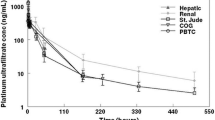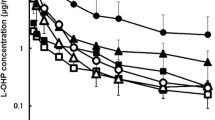ABSTRACT
Purpose
We previously reported that the product of the area under the plasma concentration–time curve (AUCp) and a toxicity factor, which in turn was defined as the product of the apparent ratio of tissue to plasma concentration (Kpapp) and the apparent hydrolysis rate constant (khydrolysis), was a determinant of the different degrees of toxicities induced by platinum drugs, cisplatin, carboplatin and nedaplatin. We tested this model with oxaliplatin.
Methods
Oxaliplatin was administered to rats by intravenous bolus or infusion, and the linearity of pharmacokinetics, total clearance and the Kpapp at steady state were determined. khydrolysis was determined in vitro. Nephrotoxicity was estimated from blood urea nitrogen (BUN) level and myelosuppression from platelet count.
Results
The platelet count decreased dose-dependently, but BUN did not increase significantly. The degree of decrease in platelet count caused by oxaliplatin and the other three platinum drugs was not explained by the differences of AUCp and AUC for the bone marrow but was fitted by a combination of AUCp and the toxicity factor (r = 0.908, P < 0.001).
Conclusion
The product of AUCp and the toxicity factor is a useful predictor of the degree of toxicity of oxaliplatin as has been observed with other platinum drugs.




Similar content being viewed by others
Abbreviations
- oxaliplatin:
-
1R,2R-diaminocyclohexane-oxalatoplatinum(II)
- cisplatin:
-
cis-diamminedichloro-platinum (II)
- carboplatin:
-
cis-diammine 1-1 cyclobutane-dicarboxylato-platinum (II)
- nedaplatin:
-
cis-diammine glycolate-platinum (II)
- CLtot :
-
total clearance
- AUCp :
-
area under the concentration–time curve for plasma concentration of unchanged platinum drug
- AUCt :
-
area under the concentration–time curve for concentration of unchanged platinum drug in the tissue
- Kpapp :
-
apparent ratio of tissue concentration of unchanged drug to plasma concentration under steady-state conditions
- khydrolysis :
-
apparent first-order rate constant of hydrolysis of unchanged platinum drug
- Vdt :
-
volume of distribution of unchanged compound in the tissue
REFERENCES
Nagai N, Ogata H. Quantitative relationship between pharmacokinetics of unchanged cisplatin and nephrotoxicity in rats—importance of area under the concentration-time curve (AUC) as the major toxicodynamic determination in vivo. Cancer Chemother Pharmacol. 1997;40:11–8.
Hanada K, Odaka K, Kudo A, Ogata H. Effects of disopyramide and verapamil on renal disposition and nephrotoxicity of cisplatin in rats. Pharm Res. 1999;16:1589–95.
Hanada K, Ninomiya K, Ogata H. Pharmacokinetics and toxicodynamics of cisplatin and its metabolites in rats: relationship between renal handling and nephrotoxicity of cisplatin. J Pharm Pharmacol. 2000;52:1345–53.
Hanada K, Mukasa Y, Nomizo Y, Ogata H. Effect of buthioninesulfoximine, glutathione and methimazole on the renal disposition of cisplatin and on cisplatin-induced nephrotoxicity in rats: pharmacokinetic-toxicodynamic analysis. J Pharm Pharmacol. 2000;52:1483–90.
Hanada K, Nishijima K, Ogata H, Atagi S, Kawahara M. Population pharmacokinetic analysis of cisplatin and its metabolites in cancer patients: possible misinterpretation of covariates for pharmacokinetic parameters calculated from the concentrations of unchanged cisplatin, ultrafiltered platinum and total platinum. Jpn J Clin Oncol. 2001;31:179–84.
Dedon PC, Borch RF. Characterization of the reactions of platinum antitumor agents with biologic and nonbiologic sulfur-containing nucleophiles. Biochem Pharmacol. 1987;36:1955–64.
Nagai N, Okuda R, Kinoshita M, Ogata H. Decomposition kinetics of cisplatin in human biological fluids. J Pharm Pharmacol. 1996;48:918–24.
Hanada K, Asano K, Nishimura T, Chimata T, Matsuo Y, Tsuchiya M, et al. Use of a toxicity factor to explain differences in nephrotoxicity and myelosuppression among the platinum antitumour derivatives cisplatin, carboplatin and nedaplatin in rats. J Pharm Pharmacol. 2008;60:317–22.
Luo FR, Yen TY, Wyrick SD, Chaney SG. High-performance liquid chromatographic separation of the biotransformation products of oxaliplatin. J Chromatogr B Biomed Sci Appl. 1999;724:345–56.
Jerremalm E, Hedeland M, Wallin I, Bondesson U, Ehrsson H. Oxaliplatin degradation in the presence of chloride: identification and cytotoxicity of the monochloro monooxalato complex. Pharm Res. 2004;21:891–4.
Jerremalm E, Wallin I, Ehrsson H. New insights into the biotransformation and pharmacokinetics of oxaliplatin. J Pharm Sci. 2009;98:3879–85.
Reece PA, Bishop JF, Olver IN, Stafford I, Hillcoat BL, Morstyn G. Pharmacokinetics of unchanged carboplatin (CBDCA) in patients with small cell lung carcinoma. Cancer Chemother Pharmacol. 1987;19:326–30.
Hirabayashi K, Okada E, Oguma T, Shimamura K. Pharmacokinetics of cis-diammine (glycolato) platinum (254-S), a new platinum antitumor agent, following an intravenous and intraperitoneal infusion bioactive platinum concentration profile. Gan To Kagaku Ryoho. 1990;17:2221–7. in Japanese.
Ehrsson H, Wallin I, Yachnin J. Pharmacokinetics of oxaliplatin in humans. Med Oncol. 2002;19:261–5.
Author information
Authors and Affiliations
Corresponding author
Rights and permissions
About this article
Cite this article
Hanada, K., Suda, M., Kanai, N. et al. Pharmacokinetics and Toxicodynamics of Oxaliplatin in Rats: Application of a Toxicity Factor to Explain Differences in the Nephrotoxicity and Myelosuppression Induced by Oxaliplatin and the Other Platinum Antitumor Derivatives. Pharm Res 27, 1893–1899 (2010). https://doi.org/10.1007/s11095-010-0189-4
Received:
Accepted:
Published:
Issue Date:
DOI: https://doi.org/10.1007/s11095-010-0189-4




